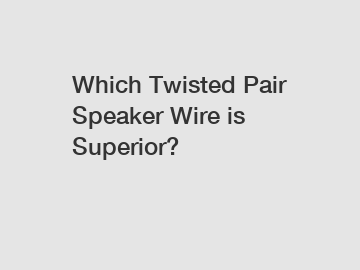Which Twisted Pair Speaker Wire is Superior?
Which Twisted Pair Speaker Wire is Superior?
Twisted pair speaker wire is a vital component for achieving high-quality sound in audio systems. With so many options available in the market today, it can be overwhelming to determine which wire is truly superior. In this article, we will explore the various types of twisted pair speaker wires and compare their features, conductivity, shielding, and price to help you make an informed decision.
1. Oxygen-Free Copper (OFC) vs. Copper-Clad Aluminum (CCA):

OFC and CCA are the two most commonly used materials for speaker wires. OFC wires are composed of pure copper, offering excellent conductivity and low resistance, which allows for efficient transmission of audio signals. On the other hand, CCA wires consist of an aluminum core wrapped in a thin layer of copper. While CCA wires are more affordable, they have higher resistance and are less efficient in transmitting signals compared to OFC wires. Therefore, if you prioritize optimal performance, it is recommended to choose OFC wires.
2. Gauge Size Matters:
The gauge size of a wire refers to its thickness, with lower gauge numbers indicating thicker wires. Thicker wires have lower resistance and are more suitable for longer distances. For short distances, a 16 or 18 gauge wire would suffice; however, for longer runs or higher power applications, a 12 or 14 gauge wire is recommended to minimize signal loss. Keep in mind that thicker wires can be more difficult to handle and may come at a higher price point.
3. Shielding for Interference Reduction:
Shielding is crucial for minimizing electromagnetic interference (EMI) and radio frequency interference (RFI). Two types of shielding commonly found in speaker wires are foil shielding and braided shielding. Foil shielding consists of a thin layer of aluminum foil that helps block interference, while braided shielding utilizes a mesh-like design made of copper or aluminum. Both options are effective in reducing interference, but braided shielding typically provides better protection. However, it's important to note that added shielding may also increase the overall cost of the wire.
4. Insulation Quality:
The insulation surrounding the wires plays a vital role in maintaining signal integrity and preventing signal loss due to external factors. Look for speaker wires with high-quality insulation, such as PVC or polyethylene, as they provide better protection against environmental factors, including moisture and heat. Additionally, good insulation ensures durability and extends the lifespan of the wire.
In conclusion, when it comes to selecting superior twisted pair speaker wire, it is essential to consider several factors. Oxygen-Free Copper (OFC) wires offer superior conductivity compared to Copper-Clad Aluminum (CCA) wires, ensuring efficient signal transmission. Gauge size should be chosen based on the desired distance and power requirements. Thicker wires are recommended for longer runs or high-power applications, while thinner wires are suitable for shorter distances. Shielding, such as foil or braided shielding, helps reduce interference and maintain signal integrity. Opt for high-quality insulation materials to ensure durability and protection against external elements.
Ultimately, the choice of twisted pair speaker wire depends on your particular audio system requirements and budget constraints. While higher-end options offer superior performance, they may not be necessary for every setup. Assess your needs, consider the factors discussed above, and make an informed decision to ensure optimal sound reproduction in your audio system.
For more Outdoor Speaker cable Manufacturer, Fiber Optic Cable Accessories, Multichannel Audio Cable Manufacturerinformation, please contact us. We will provide professional answers.



Comments
0